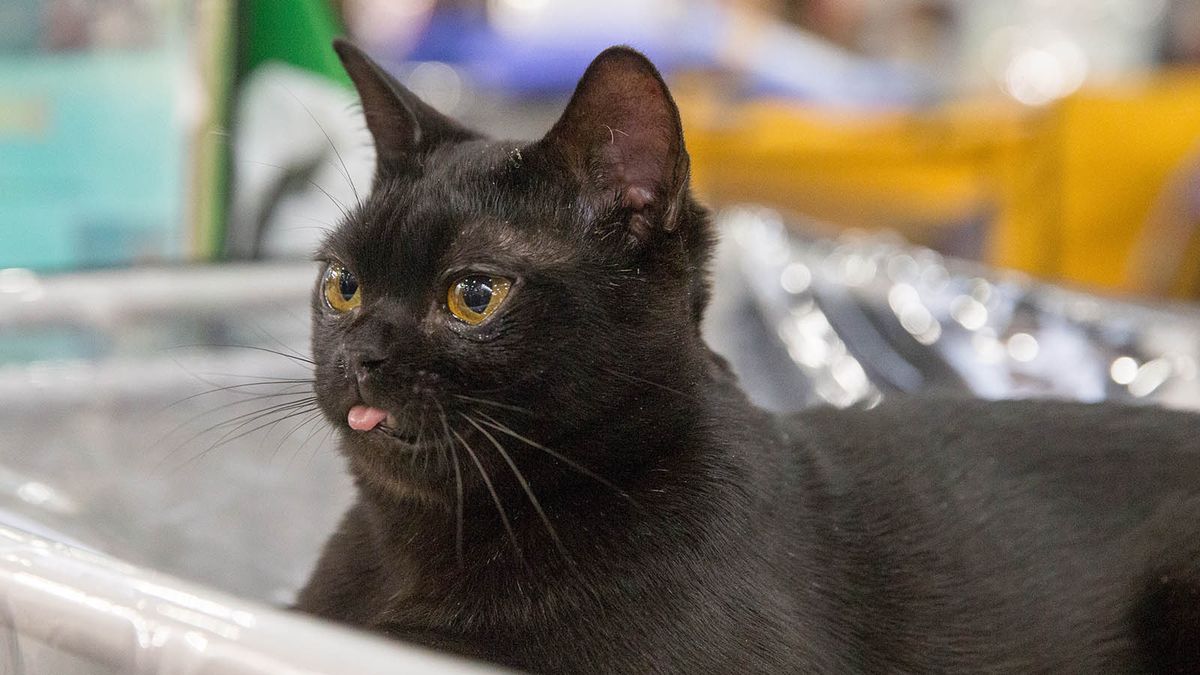If you are fascinated by the Black Panther, and you want one for yourself, then look no further. You are in luck; the black Bombay cat is what you need.
The Bombay is a domestic parlor panther and has been known to be the blackest cat in the cat fancy.
It is so black that when it is mature, the fur turns completely black to the roof, tight, short, and becomes extremely shiny, even down to the paw pads.
It’s hard to tell what is more captivating about this beauty, the shiny black coat or the golden eyes. The combination is an absolute marvel.
The Bombay cat is muscular, but a deceptively heavy animal. Don’t let the small size deceive you as it could weigh up to 6 to 11 pounds and can live up to 12 to 16 years if given proper care.
They could be likened to your typical black leopard as the Bombay walk with a sway similar to them.
History of the Bombay Cat
Cat lovers and breeders find Bombay a fine specimen because they are cross between a black American shorthair and a sable Burmese.
Amazing isn’t it? The crossing of these beauties (sable Burmese and black American shorthairs) is still allowed by the Cat Fanciers Association (CFA) and was accepted in 1976, even though Bombay is a pure breed having its own distinct look and characteristics.
The Bombay looks pretty much like the Burmese in appearance, but the Bombay is often larger than and instead not as compact as the Burmese cat. You would find a typical Bombay’s head to be round with a short muzzle.
It is challenging to produce show-quality cats because the Bombay cat is a blend of two very different breeds.
Litters would comprise of pet-quality than show-quality. Their pace of maturity is slow in appearance and may not show all their characteristics till they are 18 months.
Caring for a Bombay cat
The Bombay cat is characterized by its high affection level but loves attention and adores being carried around, preferably on the shoulder.
Their friendly nature would have them around you once they get used to you. You might even say they are “lap fungus” and might find it hard to get them off once they are there.
Their tendency to vocalize would have them say something about almost everything you do, and they have a knack for bonding most with one member of a family.
They would follow you everywhere, room to room, paying close attention to everything you do. The Bombay is a perfect cat if you are looking for a loyal and affectionate pet.
Bombays are amazing with guests, children, and even with dogs. It would be lovely if you create an environment where they can play around and exercise as freely as they can.
It is almost to find a Bombay cat in hiding; instead, you would see them snooping around in family meets, welcoming guests, and playing around with other pets.
As long as the environment is entirely conducive for them, you would enjoy the energy they bring in brightening the house.
They also love to rest in cozy warm areas when they aren’t playing and won’t always require a bathe, however, they don’t mind being brushed every once in a week.
The Bombay cat’s intelligence makes it easy to train. It can be taught to walk on a leash and even learn to play fetch.
Common health problems of a Bombay cat
Bombay cats are considered to be a healthy breed, but here are some ways to prevent them:
- It is crucial that you don’t overfeed your Bombay cat if you want it to live a long life. Obesity can significantly shorten any cat’s life, so it is best you monitor the weight of your cat.
- Regular veterinary check-ups and recommended vaccinations are vital to keeping watch of your cat’s health.
- Bombays are indoor cats and keeping them indoor helps prevent them from fighting, contacting any form of diseases, accidents or getting injured.
- Be sure to monitor your cat’s health and contact your vet whenever it has a runny nose or sinus problems.
- It is essential that you neuter a Bombay at 5 to 9 months of age. Bombays reach sexual maturity as early as five months old.
- Ensure to take care of your cat’s hygiene by toothbrushing to prevent it from contacting gingivitis.
Diet and Nutrition
Like every other cat, Bombay doesn’t require any special diet but is necessary that you provide a portion of high-quality wet food and quality dry food as well.
Discuss with a veterinarian if you notice your cat is showing signs of obesity to know best how to manage your cat’s health.
Older cats, kittens, and cats with health conditions may require special dietary plans as recommended by your vet but also make sure to provide clean, fresh water and a stress-free environment for your cats.
So what do you say? Want to get yourself a Bombay cat? You bet your cute self you want to.







